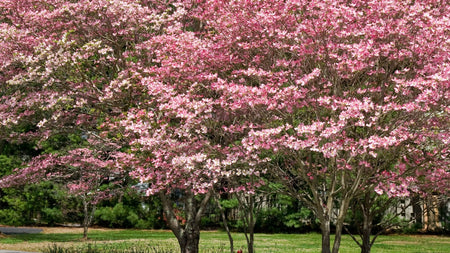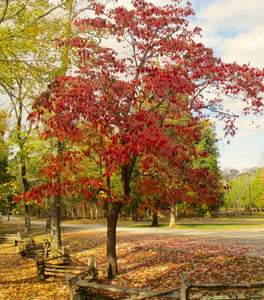
Images Depict Mature Plants
Cherokee Chief Dogwoods for Sale Online
Cherokee Chief Dogwood (Cornus florida ‘Cherokee Chief’) is a stunning native flowering tree known for its deep rose-red blossoms that brighten the spring landscape. One of the most popular cultivars of the flowering dogwood, Cherokee Chief brings bold color early in the season, blooming with large bracts that appear before the foliage unfurls. This small, deciduous tree grows 15 to 25 feet tall and wide, making it an excellent choice for specimen planting, understory gardens, and foundation landscapes where vibrant spring interest is desired.
In addition to its standout spring flowers, Cherokee Chief Dogwood offers multi-season beauty with rich green summer foliage that turns a brilliant crimson in fall. Clusters of red berries appear in late summer, providing a valuable food source for birds and other wildlife. As a native selection, this dogwood supports pollinators and beneficial insects while thriving in partial shade and well-drained, acidic soil. It is ideal for woodland edges, mixed borders, or as an ornamental focal point in both residential and commercial landscapes.
Cherokee Chief Dogwood is hardy in USDA Zones 5–9 and grows best in a location with morning sun and afternoon shade. Its compact size and elegant, horizontal branching habit make it easy to integrate into smaller yards or layered plantings beneath taller canopy trees. With its brilliant red blooms, wildlife value, and seasonal color, Cornus florida ‘Cherokee Chief’ is a beautiful, low-maintenance native tree that brings lasting charm and ecological benefits to your garden year after year.

| Hardiness Zone: | 5-9 |
|---|---|
| Mature Height: | 20 to 25 Feet |
| Mature Width: | 20 to 25 Feet |
| Classification: | Broad leaved deciduous tree, flowering tree |
| Sunlight: | Full sun to part shade |
| Habit: | Medium branching |
| Foliage: | Green; deep red fall color |
| Flower Color: | Rosy-Red |
| Pruning Season: | No pruning needed |
| Soil Condition: | Any well drained soil |
| Water Requirements: | Water well until established |
| Uses: | Tolerates all soil types and full sun |
How to Care for Cherokee Chief Dogwood
Be sure to read our planting instructions to ensure a healthy and happy Cherokee Chief Dogwood for years to come!
How do I plant a Cherokee Chief Dogwood Tree?
Planting a Cherokee Chief Dogwood (Cornus florida ‘Cherokee Chief’) starts with choosing the right location—this native ornamental tree thrives in partial shade with well-drained, acidic soil. Look for a site that offers morning sun and afternoon shade, which helps protect the tree from summer heat stress and promotes healthy flowering. Dig a hole twice as wide as the root ball and just as deep, loosening the surrounding soil to encourage root expansion. Place the tree in the hole with the root flare (where the trunk meets the roots) at or slightly above ground level, then backfill with a mix of native soil and compost. After planting, water the tree deeply and apply a 2–3 inch layer of mulch around the root zone, keeping it a few inches away from the trunk to prevent rot. Cherokee Chief Dogwood benefits from consistent moisture during its first growing season, so monitor the soil regularly and water when the top few inches feel dry. This small deciduous tree is perfect for foundation beds, woodland borders, and mixed native plantings, adding rich spring color and year-round beauty to the landscape. With proper planting and early care, your Cherokee Chief Dogwood will establish quickly and reward you with decades of ornamental value and pollinator support.
How do I water Cherokee Chief Dogwood Tree?
Watering a Cherokee Chief Dogwood (Cornus florida ‘Cherokee Chief’) correctly is essential for establishing a strong root system and maintaining vibrant seasonal interest. During the first growing season, water deeply once or twice a week, ensuring that the soil remains consistently moist but not waterlogged. These native trees prefer well-drained, slightly acidic soil and benefit from watering at the base of the trunk to avoid wetting the leaves, which can help reduce the risk of disease. A slow, deep soak encourages deep root growth, improving the tree’s drought tolerance as it matures. Once established, Cherokee Chief Dogwood typically needs supplemental watering during dry spells, especially in the heat of summer or in sandy soils. Apply a 2–3 inch layer of mulch around the base of the tree to conserve moisture, moderate soil temperature, and suppress weeds—taking care to keep mulch a few inches away from the trunk. Regular watering is especially important during periods of drought or high heat, as stress from dry conditions can reduce flowering and fall color. With proper irrigation practices, your Cherokee Chief Dogwood will thrive, offering year-round beauty and supporting local pollinators and wildlife.
How do I fertilize Cherokee Chief Dogwood Tree?
Fertilizing a Cherokee Chief Dogwood (Cornus florida ‘Cherokee Chief’) should be done with care to encourage healthy growth, vibrant foliage, and abundant spring blooms. The best time to fertilize is in early spring, just as new growth begins. Use a slow-release, balanced fertilizer such as 10-10-10, or one specifically formulated for acid-loving plants. Apply the fertilizer evenly around the tree’s drip line—where rain naturally falls from the canopy—and avoid placing it directly against the trunk. Water thoroughly after applying to help nutrients soak into the soil and reach the root system. Over-fertilizing can harm dogwoods, especially young trees, by promoting weak, leggy growth or increasing their vulnerability to disease. If your soil is already rich or has been amended with compost, you may only need to fertilize every other year. A soil test can be helpful in determining specific nutrient needs, especially for long-term care. Cherokee Chief Dogwood thrives best in slightly acidic, well-drained soils, so consider using organic amendments like pine bark mulch or composted leaves to enhance soil health naturally. With mindful fertilization, this native flowering tree will reward you with brilliant red blooms in spring, lush summer foliage, and stunning fall color.

How and when do I prune a Cherokee Chief Dogwood Tree?
Pruning a Cherokee Chief Dogwood (Cornus florida ‘Cherokee Chief’) should be done with a light touch to preserve its natural, horizontal branching habit and graceful shape. The best time to prune is in late fall or winter when the tree is dormant and the risk of disease, such as dogwood anthracnose, is lower. Begin by removing any dead, damaged, or diseased branches, followed by any crossing limbs that could cause future rubbing or breakage. Avoid heavy pruning, as dogwoods are slow-growing trees that don’t recover quickly from drastic cuts. If necessary, you can lightly shape your Cherokee Chief Dogwood to improve air circulation and overall appearance, especially in its early years to encourage strong structure. Avoid pruning in spring or summer, as this can interfere with flowering and make the tree more susceptible to stress or pest issues. Keep tools clean and sharp to prevent disease transmission. When pruned properly and at the right time, this native ornamental tree will maintain its beautiful form, deliver breathtaking red spring blooms, and remain a healthy focal point in your garden for years to come.






















